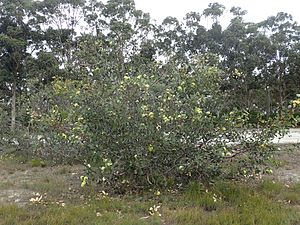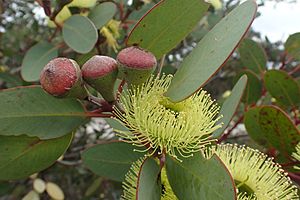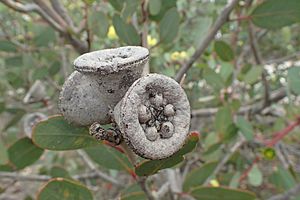Bell-fruited mallee facts for kids
Quick facts for kids Bell-fruited mallee |
|
|---|---|
 |
|
| Eucalyptus preissiana in Helms Arboretum, near Esperance | |
| Scientific classification | |
| Genus: |
Eucalyptus
|
| Species: |
preissiana
|
The Eucalyptus preissiana, also known as the bell-fruited mallee, is a type of small tree or shrub. It grows in Western Australia, in the area between Albany and Esperance. This plant often spreads out, has smooth bark, and leaves that are shaped like eggs or ovals. Its flower buds grow in groups of three, and when they open, they show bright yellow flowers. The fruit looks like a cup, cone, or bell.
Contents
What the Bell-fruited Mallee Looks Like
The Bell-fruited Mallee is a type of Eucalyptus plant called a mallee. This means it usually grows as a shrub or a small tree, reaching about 3 to 5 meters (10 to 16 feet) tall. It has a special woody swelling at its base called a lignotuber. This helps the plant grow back after a fire.
The bark of this mallee is smooth and can be greyish or brown. Young plants and new shoots growing from the base have stems that are square. Their leaves are greyish-green, about 5 to 9.3 centimeters (2 to 3.7 inches) long and 3 to 6.2 centimeters (1.2 to 2.4 inches) wide. These young leaves grow in pairs, one across from the other.
As the plant gets older, its leaves can sometimes grow in an alternating pattern. They are a dull greyish-green on both sides, shaped like an oval or egg. These adult leaves are usually 6.5 to 13 centimeters (2.6 to 5.1 inches) long and 2.5 to 5 centimeters (1 to 2 inches) wide. They grow on a leaf stalk, called a petiole, which is 1 to 4 centimeters (0.4 to 1.6 inches) long.
The flower buds grow where the leaves meet the stem, on a flat, unbranched stalk (a peduncle) that is 0.8 to 2.5 centimeters (0.3 to 1 inch) long. Each individual bud has its own small stalk (a pedicel) about 0.2 to 0.5 centimeters (0.08 to 0.2 inches) long. When the buds are ready to open, they are oval-shaped, 1.5 to 2.6 centimeters (0.6 to 1 inch) long and 1.3 to 1.8 centimeters (0.5 to 0.7 inches) wide. They have a cap-like top called an operculum.
This mallee blooms from September to November, showing off its bright yellow flowers. After flowering, it produces a woody seed pod, called a capsule. These pods are shaped like a cup, cone, or bell, measuring 1.5 to 2.7 centimeters (0.6 to 1.1 inches) long and 2 to 3.8 centimeters (0.8 to 1.5 inches) wide.
How the Bell-fruited Mallee Got Its Name
The Eucalyptus preissiana was first officially described in 1844 by a scientist named Johannes Conrad Schauer. He wrote about it in a book by Johann Georg Christian Lehmann called Plantae Preissianae.
The second part of the plant's scientific name, preissiana, honors Ludwig Preiss. He was the person who collected the very first plant sample, known as the type specimen, near Cape Riche in 1840. This sample was used to describe and name the species.
In 1995, two other scientists, Ian Brooker and Andrew Slee, described two different types, or subspecies, of Eucalyptus preissiana. These names are now officially accepted:
- Eucalyptus preissiana subsp. lobata: This subspecies has larger parts, called lobes, between the openings of its fruit.
- Eucalyptus preissiana subsp. preissiana: This subspecies has fruit with no lobes, or only very small ones, below the rim of the fruit.
Where the Bell-fruited Mallee Grows
The Bell-fruited Mallee likes to grow in areas near the coast or just inland. It is often found in soils that contain limestone or laterite, which are types of rock and soil. It also grows well in gravelly, sandy-clay soils.
You can find this plant in coastal and near-coastal regions. Its range stretches from the Stirling Range to the Fitzgerald River National Park, and almost as far east as Esperance. The subspecies lobata is found only in a few coastal spots between Esperance and Hopetoun.
Protecting the Bell-fruited Mallee
The Western Australian Government's Department of Parks and Wildlife keeps track of how many of these plants are left.
The subspecies preissiana is considered "not threatened." This means there are enough of them, and they are not currently at risk of disappearing.
However, the subspecies lobata is listed as "Priority Four." This means it is rare or nearly threatened. It needs special attention to make sure its numbers don't drop too low.
Growing the Bell-fruited Mallee
The Bell-fruited Mallee can be grown in gardens in areas of Australia that have a mild climate. It doesn't do very well in hot, humid, tropical places.
It's easy to grow this plant from seeds, as they sprout easily. For the best results, it should be planted in a spot that gets full sun and has soil that drains water well.



